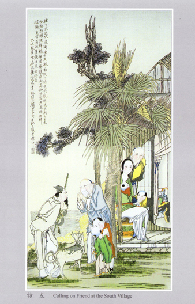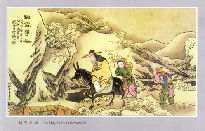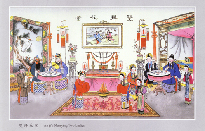
The New Year Picture is a unique art form in China that boasts a long history and far-reaching influence. During the Spring Festival(Chinese New Year), the Chinese decorate their homes with many New Year Pictures, the best of which can be found in Yangliuqing.
Many New Year Picture artists are farmers who express their good wishes and appreciation of art and life via colorful scenes embedded in the works, exerting a subtle influence on ordinary people. The folk woodblock New Year Pictures can, therefore, be regarded as an art of the farmers in terms of production and function.
A town located in the western suburbs of North China's Tianjin Municipality, Yangliuqing is one of the earliest places to employ engravers to print New Year Pictures, which were first produced between 1573 and 1620.

Most Yangliuqing New Year Picture workshops were named after its creators. For instance, the Dai Lianzen New Year Picture Workshop and Qi Jianlong New Year Picture Workshop of the early period were very famous. In the most prosperous period of New Year Picture printing, hundreds of painters and printing artisans gathered in the region. Relatively large workshops usually hired dozens of workers who worked at more than 10 printing stations. Every autumn, businessmen came to Yangliuqing to buy the pictures and then sold them elsewhere.

After the founding of new China in 1949, the People's Government paid much attention to inheriting and developing this old folk art. Now, it not only organizes people to collect and research these traditional works, but also encourages innovation. Many painters interested in Yangliuqing New Year Pictures strive to develop this art, creating many new works to reflect the new era and real life.
Characteristics of Yangliuqing New Year Pictures
Yangliuqing New Year Pictures had originated during the reign of Emperor Chongzhen in the Ming Dynasty(1368-1644) and prospered in the reigns of Emperor Yongzheng, Qianlongand Guangxu in the Qing Dynasty(1644-1911). With a long history and distinctive local flavor, the pictures are much adored by ordinary people.
Yangliuqing New Year Pictures combine woodcarving, watermarking and color painting, retain the techniques of folk paintings, and are influenced by the Qing painting workshops. Its subjects mainly include drama stories, beautiful women and plump moppets, as well as josses, door gods, images of beauties, boy and girl attendants to a god or goddess, auspicious pictures, birds and beasts, flowers, water and mountain landscapes, characters from dramas and legends. However, festivity and auspiciousness are always the main themes of Yangliuqing New Year Pictures.
Yangliuqing New Year Pictures combine delineation, woodcarving, overprinting, color painting and mounting techniques; and feature an exquisite touch, smooth lines, elaborate techniques, lifelike color paintings and a vivid luster, especially the color paintings of human faces, which are fine, bright and true to life.
The making of Yangliuqing New Year Pictures
Making a Yangliuqing New Year Picture generally adheres to the following five steps: drawing the outline, printing patterns on paper, painting the patterns and mounting the picture. Each picture is an independent creation. Unlike some artists, artisans of Yangliuqing New Year Pictures must stand erect during the process and paint on "door planks".
Workshops are equipped with a row of door planks that can be opened freely called "painting doors". Xuan paper, which contains the outline of the needed patterns, is pasted on the doors as the painter stands before the drawing. It usually takes the painter three days to two weeks to complete one picture.
The history of Yangliuqing New Year Pictures
During the reign of Emperor Shundi of the warn-torn Yuan Dynasty(1271-1368), a folk artist who specialized in engraving came to take refuge in the town of Yangliuqing. When he first set his eyes on the patches of jujube forests he thought of his special skill since the Chinese jujube tree is the best material for engravings. He then etched some pictures of door gods, kitchen gods and Zhong Kui(the protector against evil spirits and demons) to sell at festivals for a living. Later, people in the town followed suit.
In the 13th year of the Yongle reign during the Ming Dynasty (1415), when the Great Canal was dredged, fine paper and watercolors produced in South China were transported to Yangliuqing, breathing new life into the art of engraving and printing in the town.
In the mid-Qing Dynasty (1644-1911), about 100 painting workshops emerged in Yangliuqing and over 3,000 people engaged themselves in creating New Year Pictures. The town then became known as the home of New Year Pictures nationwide, where "each of its households was good at painting". By then, two schools of Yangliuqing New Year Pictures came into being - the Qi family, which excelled in painting historical stories, and the Dai family, which mainly painted dramas.
At the end of the Qing Dynasty, a new school -- the Huo family, which combined the advantages of the above-mentioned elements -- emerged, forming a triangular balance of power in the circle of Yangliuqing New Year Pictures.
After the Second Opium War(1856-1860), Yangliuqing New Year Pictures began to decline. In 1926, Huo Yutang, the fifth-generation descendent of the Huo family founded the Yuchenghao Painting Workshop -- the largest workshop in Yangliuqing. In 1958, Huo jointly established the Tianjin Yangliuqing Picture Workshop with folk artists Han Chunrong and Zhang Xingze, gradually reviving the art of Yangliuqing New Year Pictures.
The Museum of Yangliuqing New Year Pictures
Located in the courtyard of the Shi family mansion -- an ancient housing complex built in the late Qing Dynasty -- the Museum of Yangliuqing New Year Pictures is a permanent museum displaying various New Year Pictures. Boasting the largest collection of Yangliuqing New Year Pictures in China, the museum collects and displays a wealth of Yangliuqing New Year Pictures produced in the Ming and Qing dynasties and the Republic of China(1912-1949).
The artworks collected here include a very wide range of subjects, which mainly fall into four categories: historical stories, maids of honor and moppets, stage dramas and folk life. They feature soft and beautiful hues and a composition that matches the appreciative habits and folk customs of the people. The human figures portrayed in the works not only look elegant but also complement other subjects in the pictures, creating a harmonious atmosphere.
Another feature of these artworks is their vivid depiction of valuable historical events, folk customs, and so on. For instance, in June 1870 several children died of an infectious disease and were hastily buried by the Waihailou Catholic Church. A few days later, the dead bodies were found. The incident, known as the "Tianjin Religion Case," aggravated Tianjinese animosity towards foreign religions. The church was then burned and a French missionary was killed by the local people. Following the incident, artists of New Year Pictures promptly created the work "Burn the Waihailou Catholic Church".
Another example, the traditional New Year picture called "School Teaching at Yanshan," emerged around the Reform Movement of 1898 during the reign of Emperor Guangxu, which advocated equal rights to education for girls. Costumes of people depicted in Yangliuqing New Year Pictures have also changed with time. For example, pictures depicting women in cheongsams and high-heeled shoes were produced during the Republic of China.
A highlight of the exhibits at the Museum of Yangliuqing New Year Pictures is the New Year Picture lamp cases produced during the reign of Guangxu. They are actually pictures mounted inside exquisitely carved wooden lamp cases with glass in front to both prevent dust accumulation and to enable visitors to get a clear view of the works inside. When night falls, lights in the lamp cases illuminate the pictures inside so people can not only appreciate the works but also use them as wall lamps.




















